Don't wanna be here? Send us removal request.
Text
Sustainable Creatives at OCAD U: In conversation with Deanna Gene
Deanna Gene, an OCAD U alumna in Sculpture/Installation and a participant in GradEx, explores sustainability through her project "Self-Inventory." In this interview, she discusses her perspective on sustainability, the use of recycled and natural materials, and the importance of community engagement in addressing plastic waste and environmental justice. Her work emphasizes the balance between human needs and environmental health, advocating for inclusive practices that promote equity and awareness.





Your name, pronouns, and program of study at OCAD U.
Deanna Gene (She/Her) Sculpture/Installation
You self-identified your project for the Global Centre for Climate Change (GCCA). How do you personally define sustainability within the context of your work, especially considering your focus on plastic waste and environmental justice? How do you relate this to broader global and political spheres and the role for a global sustainability framework such as the United Nations Sustainable Development Goals (UNSDGs) which highlights the intersections of socio-economic and ecological systems?
On a personal level I believe sustainability is a balance between human needs and the environment. By reducing consumption and eliminating waste, our productive result is efficiency. We can all live and understand by its definition that sustainability means meeting current needs without compromising the ability of future generations to meet their own needs. It focuses on environmental health, social equity, and economic vitality. It also means accessibility. Amidst greenwashing and sustainability guilt, many people feel discouraged from engaging with sustainable practices. They need to embrace their own definition and find balance. For me, it’s not about completely avoiding plastic or exclusively shopping at refill stores. It's about making the best use of what you already have.
Community engagement is also crucial for sustainability to ensure equal access to a clean environment and address disparities in waste management and health outcomes. My project, Self-inventory aligns with global efforts to combat plastic pollution, collaborating internationally, and advocating for stronger waste management regulations. The goal is to educate others on the correlation between sustainability and marginalized communities. To not have to think about sustainability is to come from a place of privilege and frankly, ignorance. I aim to help educate and promote sustainable practices that benefit both people and the planet, and to encourage the creation green jobs and sustainable businesses. An intersectional approach would contribute to global sustainability and equity.
Could you describe the techniques and materials you use to improve environmental impact in your work, particularly in relation to the excess of plastic and recyclable materials, we all create. It also addresses the intersection between people of colour and environment injustice?
To improve the environmental impact of my work, I utilize a cordage process that involves twisting fibres together to create ropes. In my project, "Self-Inventory," I incorporated not only traditional fibres but also items like plastic bags and fabric scraps. This approach addresses the excess plastic and often discarded materials prevalent in our lives.
Soft plastics are a significant component of the cords I make because of how abundant it is in our daily lives. This reality influenced my choice of materials for the cords in my project. Growing up in an Asian household, I was taught to use every part of something, a practice that contrasts with the Western tendency to prioritize appearance over utility.
Environmental injustice is a significant concern, particularly for marginalized communities that bear the brunt of hazardous waste, resource extraction, and other harmful land uses without benefiting from them. The common practice of North America shipping its waste to other countries only worsens this issue. Toronto's recycling system is inadequate, with many people unaware of how little actually gets recycled. Worse, many people don't bother to recycle or do so incorrectly. As an artist, I strive to create without contributing to this cycle of waste and harm.
What significant challenges did you encounter to create work that considers sustainability in materials, especially considering the themes you explored? How did you address this?
When working with recycled or natural materials, I faced significant challenges due to the lack of convenience and control these materials offer compared to toxic materials. Sourcing plastic and other non-sustainable materials was straightforward because they are readily available in everyday life. However, using natural materials posed more difficulties. I had to meticulously plan to ensure I had enough foraged fibres before winter. This required careful measures to avoid over-foraging from one area, preventing the spread of invasive plants, and minimizing disturbances to natural habitats. Once gathered, these materials needed thorough preparation.
Additionally, the inability to forage during winter presented a challenge. I addressed this by incorporating materials such as banana skins and lotus leaves, which are not only natural and sustainable but also culturally significant to me. These materials allowed me to integrate an essential element of my culture into my work…food.
By adopting these strategies, I successfully overcame the challenges of creating sustainable work, ensuring that my materials and methods aligned with the themes of environmental responsibility and cultural significance.
How do you envision the role of art and design evolving in promoting sustainability in the future, particularly within the contexts you address?
I envision art and design playing a crucial role in promoting sustainability by integrating traditional cultural practices and emphasizing the use of natural materials. Historically, many cultural art practices involved slow creation processes using materials sourced from the surrounding land, which inherently promoted sustainability.
In traditional art institutions such as galleries, theatres, and museums, there often exists an imbalance between cultural representation and sustainability. My hope is to see these institutions embrace and incorporate cultural art practices that emphasize sustainable methods. This could involve showcasing works that utilize materials like natural pigments instead of synthetic ones, or bio-plastics in place of vinyl. These practices not only reduce the environmental impact but also honour the traditional methods of creating art. By adopting such sustainable practices, art and design can lead by example, demonstrating how cultural heritage and environmental responsibility can coexist. This evolution will foster a deeper connection between people and the environment, encouraging a more sustainable future in the arts.
What advice would you offer to emerging artists and designers who are interested in adopting sustainable practices?
For emerging artists and designers looking to adopt sustainable practices, it's crucial to consider the entire lifecycle of your work. Ask yourself, “Where will this work go after the exhibition?” This perspective helps me guide more sustainable choices from the beginning, ensuring minimal environmental impact even after the display period ends.
Choosing materials thoughtfully is another key aspect. Reflect on what the materials inherently convey about your piece. Sustainable materials not only promote environmental consciousness but also add unique properties and histories to your work, enriching its meaning. The process of using these materials is often more rewarding and can be more economical, as sourcing local or repurposed materials can significantly reduce costs.
Embracing sustainable practices involves reflecting on the broader impact of your work. Your choices contribute to a larger movement toward environmental stewardship and cultural preservation, inspiring others in the art and design community. Don’t hesitate to experiment with unconventional materials and techniques. Sustainable practices often push you to think creatively, leading to unique and innovative work that stands out.
Thank you, Deanna, for sharing your insights on sustainability and inspiring us to rethink our approach to art and materials! You can explore more of Deanna's work on her Instagram @dgene.art
Learn more about sustainability at OCAD U: www.ocadu.ca/sustainability
0 notes
Text
Sustainable Creatives at OCAD U: In conversation with Ievgeniia Cherednikova
Ievgeniia Cherednikova, an OCAD U alumna in Drawing and Painting who showcased her work in GradEx, explores sustainability through personal, nature-inspired experiences in her art. In this interview, she discusses her use of natural and recycled materials, her approach to sustainability, and the role of human connection with nature in her creative process.
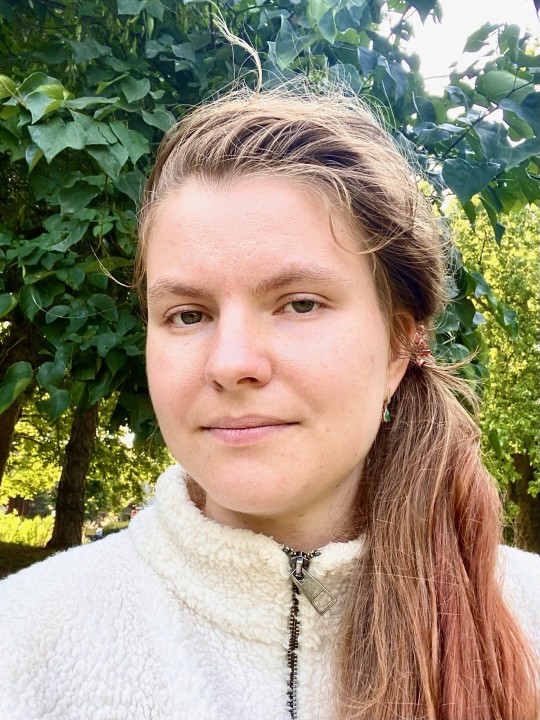

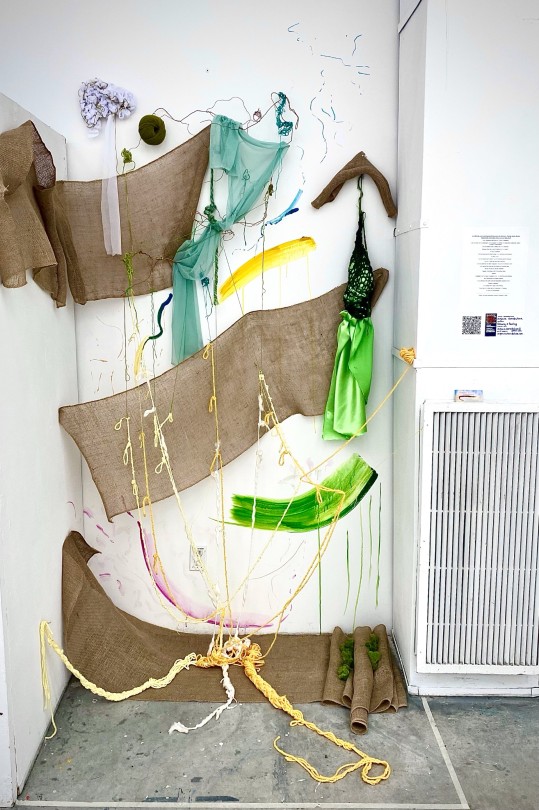
Your name, pronouns, and program of study at OCAD U.
Ievgeniia Cherednikova, she/her, alumni of Drawing and Painting
You self-identified your project for the Global Centre for Climate Change (GCCA). How do you personally define sustainability within the context of your work, especially considering your focus on plastic waste and environmental justice? How do you relate this to broader global and political spheres and the role for a global sustainability framework such as the United Nations Sustainable Development Goals (UNSDGs) which highlights the intersections of socio-economic and ecological systems?
I am making paintings (as I call them) to express my personal experiences, this time in nature. My primary purpose was simply to narrate a human experience where a person, for instance, can sit next to a tree on the soil and grass and feel grounded. Yes, Sustainability, for me, can start from a human experience. I don't identify myself with the goals of the UN, nor do I relate to them during my work. Yes, these are reasonable goals to have in front of you, yet their execution is in process; it starts from a human experience. The goals I might connect to in this work would be the joy and gratitude of the population towards soil and Earth. Yet, I acknowledge that some of them may adjacently connect to the work: responsible consumption and production, climate change, and life on land.
Could you describe the techniques and materials you use to improve environmental impact in your work, particularly in relation to climate change, rising water levels, and the textile industry?
In the second part of the body of work, I attempted to use more natural materials and recycle my work from previous purposes. These materials were mainly wool and wool yarn, burlap, soil, moss, and copper wire. Yet, I did use mesh even though it is plastic. For the first work, I used mainly wool for the bottom floor piece; everything else was mesh.
What significant challenges did you encounter to create work that considers sustainability in materials, especially considering the themes you explored? How did you address this?
I mainly attempted to use natural materials for the piece. This idea has gradually evolved into more recyclable materials, recycling my previous work. All natural materials were an additional cost; thus, ending up doing the second piece from mostly recycled materials was a solution.
How do you envision the role of art and design evolving in promoting sustainability in the future, particularly within the contexts you address?
For me, it is about a human experience. If you experience love or pleasantness and really see plants, sky, soil, and your surroundings, even your friends, as living beings, you become more perceptive. Even spending some days outdoors before you make something might be beneficial.
What advice would you offer to emerging artists and designers who are interested in adopting sustainable practices?
Try them yourself, try all the options, something might work. Don't take my word for it.
Thank you, Ievgeniia, for sharing your insights on sustainability and inspiring us to rethink our approach to art and materials! You can explore more of Ievgeniia's work on her website and follow her on Instagram @ievgeniia_cherednikova_art
Learn more about sustainability at OCAD U: www.ocadu.ca/sustainability
0 notes
Text
Sustainable Creatives at OCAD U: In conversation with Lou Rose
Lou Rose, an OCAD U alumna and featured artist in GradEx, focuses on sustainability and environmental justice in her work. Through creative reuse of materials, she addresses plastic waste and explores the life cycles of objects. In this interview, she discusses her approach to sustainable art and design..

Can you please share your name and the program you were enrolled in at OCAD university?
My actual name is Lily Davis, but I do go by Lou and my pronouns are she/her. And I was in integrated Media.
You self-identified your project for the Global Centre for Climate Change (GCCA). How do you personally define sustainability within the context of your work, especially considering your focus on plastic waste and environmental justice? How do you relate this to broader global and political sphere and the role for a global sustainability framework such as the United Nations Sustainable Development Goals (UNSDGs) which highlights the intersections of socio-economic and ecological systems?
I think sustainability kind of goes hand in hand with my work, even though it wasn’t something I initially set out to focus on. I was naturally drawn to using found and used objects, appreciating the history and the search for materials. Over time, I realized that this process aligned with sustainable practices, and it deepened my commitment to sustainability in my work.
As I became more aware of the importance of sustainability, I started making conscious decisions to reduce waste, not just because I enjoyed the process, but also to create a less wasteful practice. This has led me to think more critically about sustainability and its impact on my work.
While I'm still at the beginning of my journey in understanding broader global sustainability frameworks, such as the United Nations Sustainable Development Goals (SDGs), my thesis work has sparked a deeper interest in these areas. I recognize the importance of educating myself on different policies and practices happening globally and within my own community. My journey into sustainability is ongoing, and I’m committed to learning more and integrating these principles more consciously into my work.
Could you describe the techniques and materials you use to improve environmental impact in your work, particularly in relation to climate change and rising water levels?
In my work, I focus on using techniques and materials that minimize environmental impact. A significant aspect of my practice involves reusing and repurposing materials, especially textiles. For example, I often work with canvas from old paintings, which I repurpose in various ways. These canvases go through different lives—they might start as a painting, be used in a performance piece, and then be cut and sewn into new forms. Instead of discarding off-cuts, I save them and later sew them into new pieces, giving them a new life and reducing waste.
In addition to textiles, I also experiment with plastic materials. For instance, I collaborated with a company called Plastic Flux, which creates sheets of material from recycled plastic, like bottle caps and coffee cups. My intention was to use these sheets to create large, sculptural forms, but I realized that buying new plastic would be wasteful. Instead, I sought out scraps and off-cuts from the Plastics Department, aiming to repurpose these materials rather than contributing to more waste.
Although I didn’t have enough time to fully explore this approach in my thesis, the process was enlightening. It pushed me to think creatively about how to work with materials in a more sustainable way, and I discovered unexpected possibilities that have broadened my perspective on what materials can do in my practice.
What significant challenges did you encounter to create work that considers sustainability in materials, especially considering the themes you explored? How did you address this?
One of the significant challenges I faced in creating work that considers sustainability in materials was the limitation of resources. I often found myself hitting a wall because I didn’t have an abundance of materials to work with. This scarcity was frustrating and led to some difficult moments, but it also forced me to think creatively and problem-solve in new ways.
While it was challenging to work within these limitations, it ultimately made me more resilient and resourceful. Rather than taking the easy route of buying new materials, I had to make the most of what I had. This process, although difficult, was incredibly powerful because it pushed me to realize that you can create so much with whatever you find.
By embracing these challenges, I was able to transform frustration into creativity, finding new ways to work with limited materials. This experience has reinforced the importance of sustainability in my practice and shown me that powerful art can emerge from even the most modest resources.
How do you envision the role of art and design evolving in promoting sustainability in the future, particularly within the contexts you address?
I believe the role of art and design in promoting sustainability will continue to evolve, particularly in academic settings where creativity and resourcefulness are essential. For larger companies, the challenge lies in ensuring that sustainability is genuinely practiced rather than just used as a marketing term. In contrast, within the art world and educational institutions, there's a real opportunity to foster creative problem-solving and encourage the use of sustainable materials as part of the process. Even though I’m not perfect, I strive to make conscious, sustainable choices in my work. I hope institutions continue to promote these practices, offering more opportunities to reuse materials and explore new ideas.For me, inspiration comes from exploring unexpected places—thrift stores, discarded items, or old materials from my grandparent’s basement. I hope this approach continues to influence the way artists and designers think about sustainability in the future.
What advice would you offer to emerging artists and designers who are interested in adopting sustainable practices?
For emerging artists and designers interested in adopting sustainable practices, my advice would be to start small and focus on appreciating the materials you work with. You don’t have to overhaul everything at once, but there are many small steps you can take. For example, instead of buying new canvases, try sewing together smaller ones or repurposing old frames. There’s value in giving new life to materials that might otherwise be discarded.
Think of materials as living things with more to offer. Before you throw something away, ask yourself what else you can do with it. Old clothing can be cut up and stretched over a frame to create unique textures, or even food scraps and compost can inspire creative projects.
This approach not only promotes sustainability but also pushes you in new creative directions you might not have explored otherwise. It can be surprising and rewarding, opening up new possibilities in your work. Most importantly, have fun with it—sustainable practices can be an enjoyable and enriching part of your creative process.
Thank you, Lou, for sharing your insights on sustainability and inspiring us to rethink our approach to art and materials! You can explore more of Lou's work on her website and follow her on Instagram @lou_roses
Learn more about sustainability at OCAD U: www.ocadu.ca/sustainability
0 notes
Text
Luz Paczka: How a Health Designer tackles the globe's 5th largest greenhouse gas emitter
OCAD U's Sustainability Committee Grad Student Rep tells us about what health design has to do with climate change, and what she's doing about it.
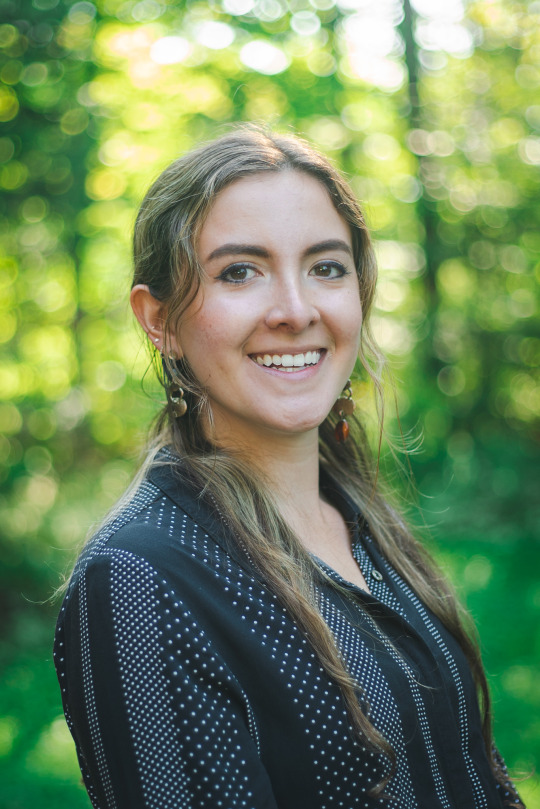
Your name and role at OCAD U?
My name is Luz Paczka and I am a second year Master’s student in the Design for Health program at OCAD U, and I am also a Sustainability Committee Grad Student Rep.
What does sustainability in health design mean?
It means to use sustainability as one of the main principles when (re)designing health systems, services, spaces, communication, and products. Furthermore, sustainability is connected to specific areas of healthcare such as health equity and inclusive design, and it can happen both at small and large scales.
Why is it important to you?
I am very passionate about this topic first all because I am an environmentalist. Second, it is because having grown surrounded by health professionals, and having become a health worker myself, I realized that although the healthcare industry looks for people’s health and wellbeing, it often does not engage in environmentally sustainable practices. In fact, global healthcare is the fifth largest contributor of greenhouse gas emissions in the world. The lack of environmentally sustainable healthcare contributes to a feedback loop in which the environmental impact of the health industry contributes to climate change, which in turn makes people sicker, therefore increasing the demand for health attention, which means increased carbon emissions, and so on. This discrepancy highlights the urgency to tackle this issue, so that healthcare cares for people beyond the hospital walls.
You just completed a field placement with the Canadian Coalition for Green Health Care. Can you tell me about the work you did there?
It was a great experience! I got to work with the Coalition as well as PEACH Health Ontario throughout my placement. By collaborating with both organizations I got to interact with people across Canada who are working on different projects with the goal of making healthcare more environmentally sustainable. I had the chance to sit in meetings where I learned about the impact of PPE [Personal Protective Equipment] on the environment (especially after the COVID-19 pandemic) and existing alternatives, and ongoing projects that promote natural systems around health facilities. I was able to bring in my health design skills even more in the development of a guidebook that recommends specific action items that can make a health facility more environmentally sustainable. I had to come in as a health designer to work on the knowledge translation and visualization of the document, while thinking about its implementations, since it was directly targeted towards leaders and executives of health facilities.
I would also like to say that during my time there, I felt very motivated by every person I encountered. Although the work to be done in sustainability is considerable, I was constantly inspired by the perseverance and the passion of all the people collaborating with the Coalition.
What do you want other Design for Health students to know about applying their skills through a sustainability lens?
I would want them to know that even if bringing sustainability to the table can be challenging in some projects, you can always come in as a health designer and explain its relevance in the corresponding context. There are several skills that we acquire through the Design for Health program, such as working in transdisciplinary teams, creative problem-solving, and context analysis, all of which are crucial to bring to a project when applying a sustainability lens. It is also important to be a good observer and listener since there are other skills that might be useful according to the context of the project, such as certain systems tools, health policy writing, research methodologies, and more
Imagine healthcare systems 10 years from now. To you, what would be an amazing shift whether locally or globally to increase sustainability in healthcare systems?
I think one of the biggest things would be to have more patient-centred care in health facilities that are (re)designed with the community so that they are sensitive to the geography, culture, economy, and language of the area. In addition, I would hope for these places to have an ongoing sustainability plan. This would decrease their environmental impact through actions that involve local and organic food, reducing of food waste, promoting net-zero or carbon-efficient modes of transportation for patients and workers, retrofitting older buildings to be more energy-efficient, opting for reusable tools and equipment, as well as divesting funds from fossil fuels to low-carbon funds. In addition, I want to highlight the importance of developing resilient healthcare spaces and services that can adapt to the changes happening around the world due to climate change. This way, we will not have to spend more resources in changing spaces and services over and over.
I know these are big items, but my hope is that health systems and spaces adopt at least a few of these action items so that they kickstart the bigger shift.
To learn more about the OCAD U Sustainability Committee and to join as a Student Rep, contact Victoria Ho, Sustainability Coordinator, Office of Diversity, Equity & Sustainability Initiatives at [email protected].
Check out our upcoming events at www.ocadu.ca/sustainability
0 notes
Text
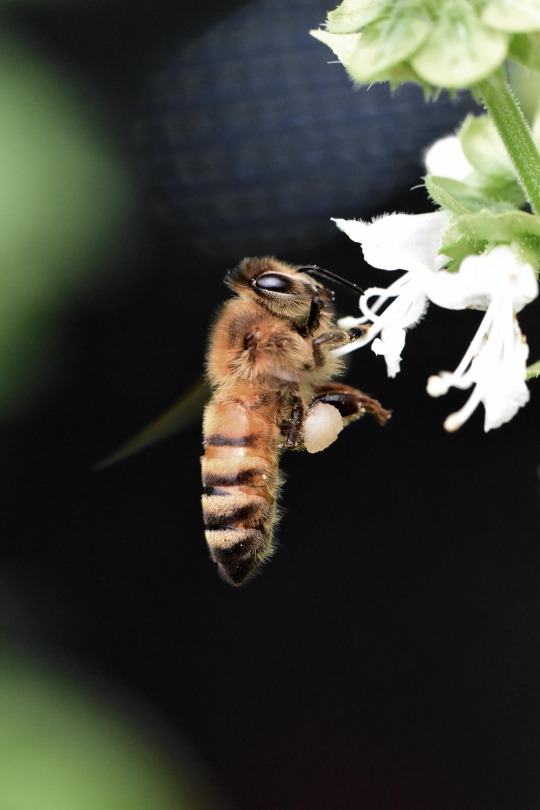
In conversation with Ryan Whyte
Behind the scenes of the 2021 OCAD U Pollinator Photo Exhibit's winning photo.
Post by Victoria Ho, Sustainability Coordinator
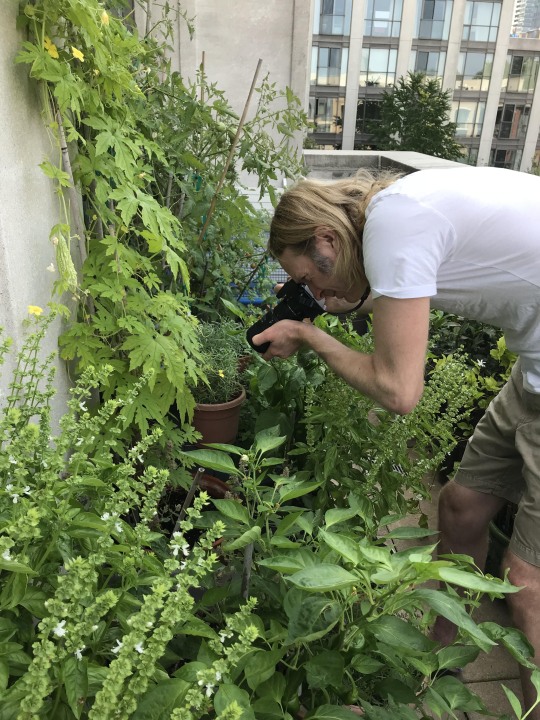
Photo of Ryan Whyte in his garden © Jennifer Purtle. All other photos © Ryan Whyte
Pollinators reveal otherwise invisible connections between a garden and its urban context.
Today we are featuring Ryan Whyte, winner of the inaugural OCAD U Pollinator Photo Exhibit. The purpose of the exhibit was to encourage the OCAD U community to be curious about their own backyards and to celebrate the hundreds of pollinator species that can be found close to home in a range of habitats. We were thrilled by the responses and the creative captions that captured joy, silliness, and reverence for our wonderful pollinators that hold up our ecosystems and food systems.
Name: Ryan Whyte
Title and role at OCAD U: Chair, BA Honours Program in Visual and Critical Studies, Associate Professor, Faculty of Arts & Science
VH: Why pollinators? What sparked your interest in photographing pollinators?
RW: My partner and I maintain a small container garden. At a certain point I became obsessed with the behavior of pollinators in our garden and realized that they constituted a fantastic photographic subject and a fascinating subject of research. Pollinators are interesting for many reasons. Their proximity—their presence just outside our door, and in any urban garden—is a reminder of the urban networks of life that we usually ignore as we go about our business. Urban planning, for instance, because it is driven by developers, almost never takes the presence of nature into account, and yet cities host important ecosystems. Pollinators reveal otherwise invisible connections between a garden and its urban context.
Pollinators are also fascinating from an evolutionary perspective. The symbiotic relationship between plant and pollinating insect is a result of co-evolution, a dramatic example of a staggeringly complex network of mutually imbricated developments within a dynamic evolutionary process. I am not a scientist, but a historian, and for me this symbiosis and its evolutionary context and history is interesting and humbling because its immense complexity echoes, and indeed surpasses, that of historical events, and the challenge of understanding it echoes and surpasses that of understanding a historical event through the multidirectional interrelationships of its context and its past. Just as the complexity of the natural world will always at some point escape our grasp, so with the complexity of history.
Another lesson we can take from pollinators lies in the convergence of systems of signification in the act of pollination. Pollen is both food and reproductive material. Its operation depends on multiple forms of signification converging on the same site, whether the visual signalling of flowers (extending beyond human vision into the UV range perceptible by many pollinators), the chemical communication of plants, the markings of insects (one kind of pollinator, the hoverfly, visually mimics bees and wasps), electrical communication between bees and flowering plants (we are just beginning to learn about this phenomenon), or insect social communication such as the famous dance of the bees. This should be interesting to artists, because it suggests a model of complex, multivalent signification that puts the simplistic, reductive language of so much contemporary art and literature to shame.
VH: Pollinators are amazing. 75% of the world’s crops depend on them. They enable flowering plants to reproduce. They prevent soil erosion. They are both critical to combating climate change and are under threat due to climate change. Do you have any climate action strategies you can share with us?
RW: If you have the means to plant a garden, you can help pollinators. Easy-to-grow, common garden plants that attract many kinds of pollinators include mint, catnip, oregano, basil, tomatoes. Unlike most self-respecting gardeners, I let everything bolt, because I want my plants to blossom and attract insects as soon as possible. The very best thing you can do is plant species native to your region, since these will draw native pollinators. The Xerces Society provides excellent resources:
https://xerces.org/bring-back-the-pollinators
Another thing you can do, whether you have the means to plant a garden or not, is familiarize yourself with local pollinators. I recommend the iNaturalist app and site. This allows you to photograph insects, upload your photographs and connect with an enormous network of naturalists who will help identify them. Your photos and identifications can then be used by scientists. This is an amazing example of citizen science, producing millions of data points that sustain research in new ways and improve our understanding of the natural world.
The best way to help pollinators is first to understand them.
There is a wealth of information that a layperson can glean from citizen science; for example, if you encounter a species unfamiliar to you, you can use the app to see how many individuals have been identified in your region and find links to in-depth information about that species. I began using iNaturalist last summer, and to date have documented and identified 85 species of insect in our tiny container garden on the fifth floor of a downtown Toronto apartment. This has prompted me to research these species, to learn, for example, which ones are native to the region, and which have been introduced by humans, thus enriching my understanding of the Toronto ecosystem and the challenges it faces. The best way to help pollinators is first to understand them.
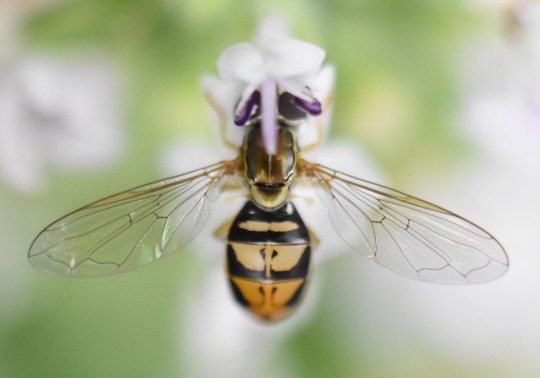
VH: Your previous research subjects have included fashion, gastronomy, and cross-cultural exchange in eighteenth-century print culture. Do pollinators relate to your research or figure into your teaching at OCAD U?
RW: Pollinators relate to my research on the history of food and its representations in art. I would say that my photographs relate to my research on and teaching of 18th-century art, in their appropriation of rococo aesthetics, and engagement with Enlightenment ideas about the perception of nature and the aesthetics of wonder. At the same time, photography, gardening, and amateur entomology are an escape from the pressures and constraints of academic life. We all need hobbies as vehicles for passions, for inspiration, to find different ways of thinking and being. For me, nature, even in the smallest urban garden, is infinitely restorative.
VH: There are over 360 native bee species living within the GTA and the average Toronto yard apparently hosts 50 bee species. Yet, the active lives of pollinators are often quietly underway without human knowledge. What do you hope that viewers will learn or appreciate from these images?
RW: I hope that viewers will enjoy a sense of awe and beauty in the natural world that I find so moving, and such a balm for the soul, and that they will gain a new awareness of the insects to which we have so many connections despite our ignorance and destruction of the natural world.
VH: Where do you live and what locations feature most frequently in your pollinator photos?
RW: I live in downtown Toronto, quite close to OCADU. All my photos are shot in our small container garden on the fifth-floor terrace of an apartment building.
VH: What equipment do you use? Any advice for shooting images of pollinators?
RW: I use a DSRL and a macro lens. These are far from the top of the line, which is a reminder that your photographs depend more on what you do with the gear than on the gear itself. You can take incredible insect photos with a cell phone and a cheap macro lens attachment.
Photographing insects is difficult. My best advice is practice, practice, practice. The joy of digital photography is that you can take thousands of photos, as you learn, at no expense. Over time, you will become familiar with the possibilities and pitfalls of different camera settings. A challenge of macro photography is its extremely shallow depth of field, and a challenge of insect photography is that insects move quickly. So, you must experiment with shutter speeds, aperture settings, ISO settings, ways of angling the camera relative to the insect body, etc. You can use a flash, which allows a smaller aperture and wider depth of field, and freezes rapid movement; or more advanced techniques like focus stacking, and more advanced gear associated with extreme macro photography such as focus rails, microscope lenses, etc. (Because I am interested in a natural aesthetic, I don’t use a flash, nor use the techniques of scientific and laboratory photography.)
With practice you also learn to identify some species by sight, which allows you to become familiar with how they move, how skittish they are, how to approach them, what time of day and in what weather they fly, which plants they like, etc. Macro photography reveals details imperceptible to the naked eye, and in so doing trains the naked eye to perceive things it did not see before. For me this is the essence of insect photography, a practice that imparts an intimate, embodied knowledge of the natural world and prompts still further research into each of the species I encounter. The opportunity to learn is limitless.
My gear: Nikon D5600, DX Micro Nikkor 85 mm f/3.5, a cheap set of extension rings (I usually use the 36mm), and a set of close-up (macro) filters that I rarely use. My shots are all hand-held with no flash.
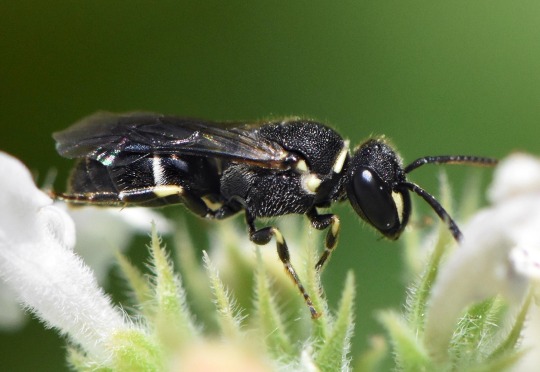
-----------
Thanks Ryan for sharing about your world of pollinators! You can check out more of Ryan's images amongst the other photo submissions online at the 2021 OCAD U Pollinator Photo Exhibit.
Learn more about sustainability at OCAD U: www.ocadu.ca/sustainability
2 notes
·
View notes
Video
tumblr
Sustainable Creatives at OCAD U: Bhavana Jalali, 4th-year Material Art & Design student
Interview and Video by Aashish Arora
Today’s conversation features Bhavana Jalali, a 2nd year Material Art and Design student with a focus on textiles and jewelry. She moved to Canada from India for post secondary education and she is often inspired by the multi cultural essence of Toronto and tries to reflect that in her art and design practice.
What does sustainability personally mean to you and how it is reflected in your work and process?
Growing up the youngest in my family, I often reused clothes and belongings of my elder brother, sister, parents, aunts, etc. Sustainability was a natural choice for me. The fashion industry is one of the most harmful to our environment and I strongly believe in repurposing items by reusing, recycling or recreating them.
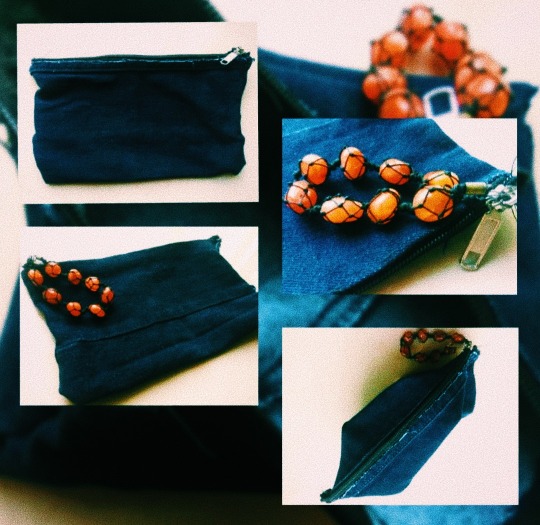
A brief summary of your project
My project involves the creation of a handbag, pouch and wristwatch using denim from an old pair of jeans that were no longer fit for my wearing. All items were hand-sewn by me.
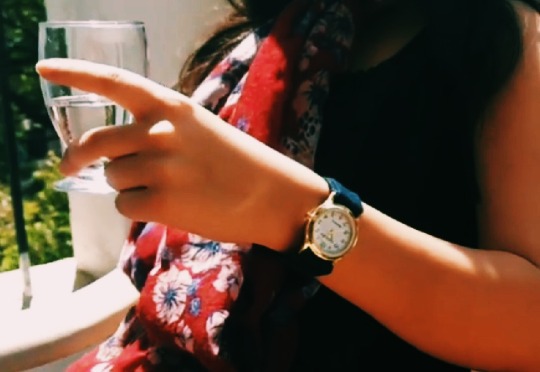
What inspired you to include sustainability in your creative process and thinking? I felt that sustainability would save me time, money and more importantly, it would save our environment of some denim waste.
Any advice that you would like to give to your fellow peers
An advice I have adopted and would love to give to my peers is to consider the number of ways an item can be used every time one makes a purchase.

Source: https://fashiontakesaction.com/facts/
About the Author
My name is Aashish Arora, and I am in fourth year Graphic Design at OCAD University. I have been working as a student monitor for the Office of Diversity, Equity and Sustainability for the past two years. I started the Sustainable Creative Video Interview series, to help showcase the work of students and their interests relating to sustainability.
My personal understanding of sustainability is this idea of thinking inclusively, when making decisions while spending. From a young age, my mother taught me about this “want or need” concept. Growing up, I was always asked to explain a reason before I bought anything new, and I always had to justify my need for any purchase. This is how sustainability started to become a part of my lifestyle.
Growing up in India, I have seen the people there shift from traditional practices, like drinking tap water to buying single-use plastic water bottles, which is an environmental impact. I have also witnessed the quality of water decreasing, because of those industrial needs that people have created. This had inspired me to education myself on these issues, and to be more cautious when making my lifestyle decisions.
I think that sustainability education and community involvement are both important, in the way that it can help people share their ideas of sustainable practices. I hope that this series will help fellow students and viewers to learn more about sustainability.

We want to know how you are adapting to your art & design practice while studying remotely! To participate in the Sustainable Creatives series, email [email protected].
0 notes
Video
tumblr
Sustainable Creatives at OCAD U: Nour Abdulhussain, 4th-year Environmental Design student
Interview and video by Aashish Arora
Today’s conversation features Nour Abdulhussain, a 4th year environmental design student specializing in interior design at OCAD University. Her main objective is creating designs that have an impactful effect on humans through blurring the boundaries between landscape, architecture and interior. Check out the above video and keep reading for the interview!
What does sustainability personally mean to you and how it is reflected in your work and process?
As a student in design finding ways to create a sustainable designs can be difficult within theoretical projects however, in practice sustainability for me includes two major elements : repurpose and reuse. These two elements can change the perspective people have to everyday materials and simplify the process.
A brief summary of your project
The project - Bulwer Home Concept Model - is a design to emulate elements such as Movement, light, a relationship between private/public and self-expression. This dynamic model is also made with 100% reused, repurposed and recycled material including lime green acrylic from a first year project, twisted mesh metal from a broken paper tray and textured paper from the re-use depot.
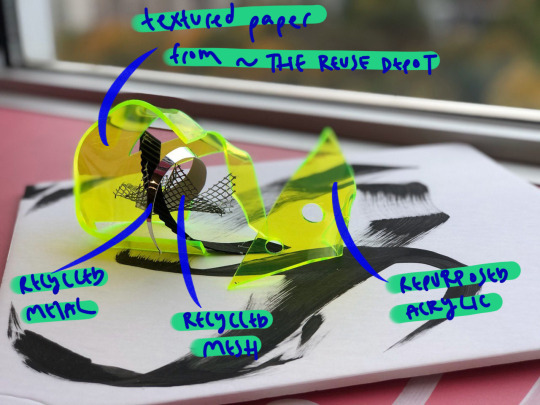
What inspired you to include sustainability in your creative process and thinking
In my second year project my core ED professor pushed me to expand my knowledge and my designing process and after researching a lot about different aspects of design and the impact of the industry I had a shift in perspective and became inspired.
Now I try to practice what I preached and grow as a designer with a set of goals and sustainability is always included.
Any advice that you would like to give to your fellow peers
Practicing sustainability is not about being the perfect role model, it’s about trying to practice design in the most impactful way. It will also push you as a designer to be more creative, the fear or intimidation to create beautiful designs should not restrain you to use new materials and it is possible through more sustainable practices.
Sustainable design is more than a concept or a trend, it's a necessary form of design that needs to be adopted within the industry and as future designers we must take the necessary steps to achieve this.
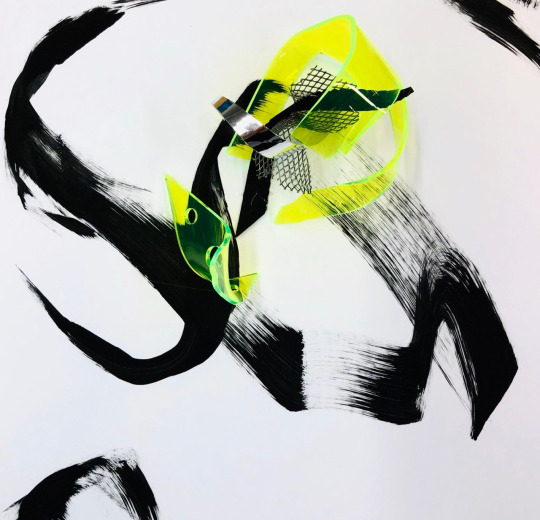
About the Author
My name is Aashish Arora, and I am in fourth year Graphic Design at OCAD University. I have been working as a student monitor for the Office of Diversity, Equity and Sustainability for the past two years. I started the Sustainable Creative Video Interview series, to help showcase the work of students and their interests relating to sustainability.
My personal understanding of sustainability is this idea of thinking inclusively, when making decisions while spending. From a young age, my mother taught me about this “want or need” concept. Growing up, I was always asked to explain a reason before I bought anything new, and I always had to justify my need for any purchase. This is how sustainability started to become a part of my lifestyle.
Growing up in India, I have seen the people there shift from traditional practices, like drinking tap water to buying single-use plastic water bottles, which is an environmental impact. I have also witnessed the quality of water decreasing, because of those industrial needs that people have created. This had inspired me to education myself on these issues, and to be more cautious when making my lifestyle decisions.
I think that sustainability education and community involvement are both important, in the way that it can help people share their ideas of sustainable practices. I hope that this series will help fellow students and viewers to learn more about sustainability.
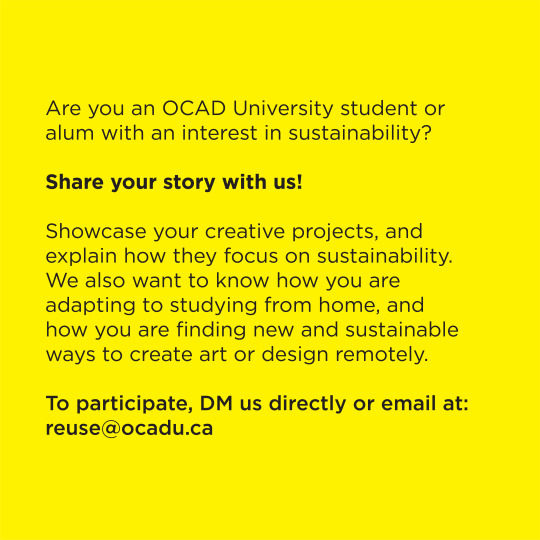
We want to know how you are adapting to your art & design practice while studying remotely! To participate in the Sustainable Creatives series, email [email protected].
0 notes
Photo

"Miijim: Food as Relations" is a series of conversations presenting Indigenous, Black and People of Colour food scholars, growers, artists and advocates who will gather virtually across Canada. The series will discuss the interconnections between art, earthwork, cultivation and harvesting experiences that decenter colonial frameworks, while thinking through labour and power relations related to food justice in urban and rural communities.
Join us on November 10th, 2:30-4:30 pm, for "MIIJIM: Anishinaabe and Haudenosaunee Food Systems." This conversation will examine food systems as specific to cultures, nations and territories. This event brings together medicine and food scholars and knowledge keepers Joe Pitawanakwat from Wikwemikong First Nation, William Kingfisher from Rama First Nation and Chandra Maracle from Six Nations of the Grand River, to discuss their food-work, and to add nuance and complexity to the potentially flattening term “Indigenous food system.”
Visit https://miijimfoodasrelations.eventbrite.com/ for more information!
0 notes
Text
Festival of the Body - Feb. 12 Opening Night - The Round Conversation
Festival of the Body’s Opening Night is February 12. Join us for a performance and Round Conversation with exhibiting student artists, faculty and community members on the themes of environmental justice & materiality; responsibility to others; and responsibility to self. Co-moderated by student Maya Skarzenski-Smith (Faculty of Art) and Sustainability Coordinator Victoria Ho (ODESI).
100 McCaul, Great Hall, Floor 2. Performance 5-6pm Round Conversation 6-8pm
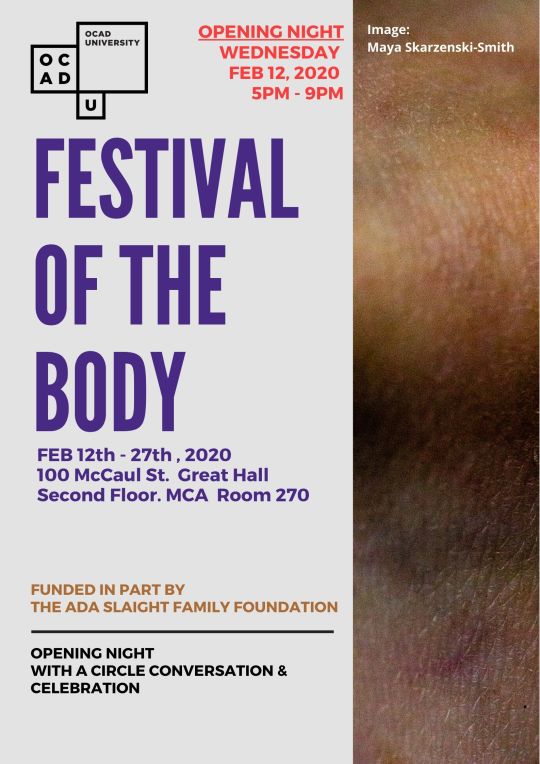
Anne Bourne, Guest Speaker
Anne Bourne is a composer, interdisciplinary artist and teacher, based in Canada. Seasoned in international intermedia performance and song recording, Anne creates emergent streams of cello, and voice in contemporary dance, film, electroacoustic and improvised music, with artists such as Eve Egoyan and Mauricio Pauly, Christopher Willes, Silvia Tarozzi, and Felicia Atkinson. Anne imparts the text scores and deep listening® practice of composer Pauline Oliveros (1932-2016) offering an experience of collective creativity, symbiotic listening and place; as faculty at Banff Centre for Art and Creativity, Collective Composition Lab; The Acts of Listening Lab, Concordia, Montreal; and recently for Killowatt at Le Serre dei Giardini Margherita, Bologna, Italy; and as MMM_MM / Ensemble Vide artist in residence in Genève, CH 2020, Anne received a Fleck Fellowship in 2017 and a Chalmers Fellowship in 2019 to research cultural and environmental thresholds. Anne will compose and perform ‘her body as words’ a new work exploring indigeneity and female identity, by choreographer Peggy Baker in March 2020. Anne believes creative expression is an opportunity for subtle evolution, through listening.
Jody Chan, Guest Speaker
Jody is a writer, drummer, organizer, and therapist-in-training. They believe deeply in the importance of storytelling, care, and joy in movement-building. They work at The Leap, organize with the Disability Justice Network of Ontario, and drum with the Raging Asian Womxn Taiko Drummers.
Dr. Sanja Dejanovic, Guest Speaker
Dr. Sanja Dejanovic is a thinker in motion and in relation with otherness. She engages multiple media and modes of expression to explore sympoiesis; the together making of space, time, and sense by living beings. She did her SSHRC Postdoctoral Fellowship work at Senselab and CISSC at Concordia, Montreal and Bard, NY, and a PhD on sense in Gilles Deleuze’s writings at York University. Interested in Western and Eastern somatic praxis, Sanja has training in sensorimotor psychotherapy and mindfulness. She has organized butoh practice labs in Toronto since 2017 and offers workshops through her somatic learning lab Body Ecologies.
Sanja is a published author, an editor, and a curator, most notably of the text (Jean-Luc) Nancy and the Political (Edinburgh University Press, 2015). She has curated Becoming-Elemental at Seneselab, Sonic Fabulations, and most recently Line. Bridge. Body. Sanja has performed and shared her work domestically and internationally, including at EPTC, The School of Making Thinking, Somatic Engagement CATR (Canadian Association for Theatre Research), Arts Unfold--Water Residency, and most recently, with Mika Lior, scores for Listening With/In Nonhuman Publics in connection with the Ecology & Performance Working Group at the 2019 American Society for Theatre Research. She is passionate about collaborating with other artists in her community. Sanja is from Skopje, Macedonia.
Johanna Householder, Guest Speaker
Johanna Householder works at the intersection of popular and unpopular culture in video, performance art, and choreography. Her interest in how ideas move through bodies has led her often collaborative practice and inform her research and writing on the impact that performance and other embodied practices have had in contemporary art and new media.
She has recently performed at the VIVA! Festival in Montréal, Performancear o Morir (Perform or Die in Norogachi, Mexico. In 2017, she reset her 1978 solo improvisation, 8-Legged Dancing, on dancer Bee Palomina in Residuals, a presentation of her performance works at the Art Gallery of Ontario, curated by Wanda Nanibush.
Her video collaborations with B.H. Yael and with Frances Leeming We did everything adults would do, what went wrong? have screened in venues internationally.
With Tanya Mars, she has co-edited two anthologies of performance art by Canadian women: Caught in the Act: (2005), and More Caught in the Act (2016). She is a founder of the 7a*11d International Festival of Performance Art which will hold its 13th biennial festival in Toronto in October 2020. She is a Professor in the Faculty of Art and Graduate Studies, and currently Chair of Cross-Disciplinary Art Practices.
Marissa Largo, Guest Speaker
Marissa Largo is a researcher, artist, curator, and educator whose work focuses on the intersections of race, gender, settler colonialism, and Asian diasporic cultural production. She earned her PhD in Social Justice Education from OISE, University of Toronto (2018). She is a recipient of the 2019 Outstanding Dissertation Award from the Research on the Education of Asian and Pacific Americans (REAPA) special interest group of the American Educational Research Association (AERA). Her book manuscript, Unsettling Imaginaries examines Filipinx artists who adopt decolonial diaspora aesthetics as counternarratives to the dominant stereotypes that persist in Canada. Her art and curatorial projects have been presented in venues and events across Canada, such as the A Space Gallery (2017 & 2012), Open Gallery of OCAD University (2015), Royal Ontario Museum (2015), WorldPride Toronto (2014), and MAI (Montreal, arts interculturels) (2007). Dr. Largo is co-editor of the anthology Diasporic Intimacies: Queer Filipinos and Canadian Imaginaries (Northwestern University Press 2017) and serves as the Canada Area Editor of the Journal of Asian Diasporic Visual Cultures and the Americas. Marissa is the Department Head of Visual Arts and Technology at a self-directed secondary school in Toronto and a sessional instructor at the Ontario College of Art and Design University.
Julius Poncelet Manapul, Guest Speaker
Julius Poncelet Manapul is a migrant Filipinx artist from the Ilocano tribe, with Spanish heritage and Cherokee ancestry; a descendant of Maria Josefa Gabriela Carino de Silang, known as an anti-colonial fighter during the 18th century Spanish rule over the Philippines—the first female leader of a Filipino movement for independence from Spain. This background informs their research and artistic practice, as they excavate the experience of immigration and assimilation through cultural erasure.
Addressing eternal displacement through themes of colonialism, sexual identity, diasporic bodies, global identity construction, and the Eurocentric Western hegemony, Julius’ artwork focuses on the hybrid nature of Filipinx culture after colonialism and the gaze of queer identities as taxonomy. Their recent research project looks at the narratives for many diasporic queer bodies that create an unattainable imagined space of lost countries and domestic belongings through colonial pedagogy of knowledge and globalized imperial power. Hybrid images question the problematic side of queer communities that uphold homonormativity through whitewashing and internalized racism, and act to challenge forms of oppression.
Julius was born in 1980 Manila, Philippines and immigrated to Toronto in 1990, attained a BFA from the OCAD University in 2009, A Professional Practice Certificate at Toronto School of Art in 2011, and completed a Masters of Visual Studies and a Sexual Diversity Studies Certificate from the University of Toronto in 2013, and an Apparel Tech in the Fashion Exchange Program at George Brown Collage in 2019. Their work had been presented at the Art Gallery of Ontario, Koffler Gallery, University of Waterloo Gallery, A Space Gallery, PM Gallery, Propeller Gallery, Nuit Blanche in Toronto (2010, 2012 & 2014), and WorldPride Toronto (2014), Julius’ work had been featured on CBC Series “Art is My Country” 2018 and “Art Works” 2017, Julius’ research had been published in Academic Journals titles “Diasporic Intimacies: Queer Filipinos and Canadian Imaginaries” and “Asian Diasporic Visual Cultures and the Americas” Vol 1. They have exhibited works in Canada, UK, France, Germany, and US.
Anna McMullen, Exhibiting Artist
Anna McMullen is constantly painting over old and new works of hers, never fully satisfied, never able to truly make up her mind about the final form of her art. This process is a reflection of her stream of consciousness; the continuous flow of thoughts, opinions, and emotions running through her mind. And in the context of these specific works, we are speaking about her ambivalence toward the desire to be seen as beautiful and to fit into the mould versus not wanting to conform to oppressive narrow standards of beauty. By painting self-portraits and using pentimento, Anna wants to express her indecisiveness; “Do I want to conform to standards of beauty, or do I want nonconformity?” Just like the final form of her work, she will never know.
Ehiko Odeh, Exhibiting Artist
The principle subject matter explored in Ehiko’s artworks are the tradition Nigerian masks, identity, sexual violence and the representation, perception of Black hair in Nigeria and Canada. Her artistic style is characterized through an expressive pallet, and the use of a variety of textiles. Ehiko also emulates the traditional Nigerian practice of craftsmanship through her multi-medium paintings, performances, drawings and installations. Her use of diverse mediums is a result of a belief that “Nigerian art” cannot be interpreted through just one form, but rather through a range of artistic expression.
James Okore, Exhibiting Artist
Throughout James Okore’s life, he’s been questioning the barriers of misunderstanding and misinterpreting others through language. This is especially true for somebody like himself with an “invisible disability.” He’s been trying to acknowledge his own actions and the ways in which he might come off towards others, and to take ownership in that. It’s a struggle at times to decipher language, and to understand whether or not to continue conversing with people, if he’s not able to pick up on subtle verbal/non-verbal cues. He’s always trying his best to understand the nuances of language, and in many cases, he finds himself confused in the process of understanding others. This piece entitled “Barriers of Language Unspoken,” addresses the essence of the BODY through his efforts in conveying an internal battle with himself trying to understand others, externally, which captures these emotions and feelings through a vessel, represented visually through the BODY.
Ash Randall-Colalillo, Exhibiting Artist
Introducing Ash Randall-Colalillo; pronouns are she/her. She is a queer interdisciplinary artist studying within her fourth year of Drawing and Painting. She creates through many varying mediums such as performance, sculpture/installation, video and drawing/painting. She allows her choice of medium to be driven from conceptual thought. Over a couple of years, her practice has developed to focus on the study of self or self-illusion/reflection, the body and the relationships they have with spaces, objects and moments. The witnessing bodies perceptions of her work within those relations motivates the "experience" to be a large part of her process when creating. She consistently questions what is an experience, and how can an experience be shared or private and what that displays for and in the work. Once understanding what an experience is within this methodology, the work expands larger than the product itself.
The piece that she created titled "FLESH FUNCTIONS” was an early exploration of this process. It is displaying a physical study of bodies and the experiences they have with vessel-like objects. Through having knowledge from the theory “The Thing” by Martin Heidegger that she studied within a class she took, she was able to use this knowledge to reflect on the relationships we make with objects as “things” and deconstructed these items and the functions of them in an abstract lens. This led to challenging the idea of the ‘thingly’ qualities within objects and their relationship dynamic with bodies mentally and physically.
In regards to this challenging, she begs the question - how do ‘ordinary’ objects gain these qualities to become or identify as things? How do they work differently, once the relationship between body and object becomes more complex within identification? This is where she aims to construct a different phenomenon of these objects and exchanges by using her physical form to "embody" the object. She attempts to take away the relationship of functionality of an object as its self and display those functions through the ‘thing’ that those objects are functional for - the body - thus becoming flesh functions.
0 notes
Text
Sustainable Creatives at OCAD U: Arya Djenar

Arya Djenar, 3rd Year Graphic Design Student at OCAD University
Interview by Aashish Arora
Today in conversation we have Arya Djenar, a third-year graphic design student at OCAD University. Arya has an interest in constructing and building objects out of reusable materials.
This hobby has inspired him to create sustainable products and change his way of ideating while designing for the real world.
His theory of thinking of everything as Zero Waste has helped him create functional products from unconventional materials. Arya always tries to leave no waste or as minimal waste possible.
What Arya enjoys the most is “The Process.” From finding scrap materials either at school or at home, to thinking about all the possible ideas, to finally creating a functional product. This all makes the journey very meditative for him.
Any time he thinks of purchasing a product, he always attempts to make it on his own before investing the money. This is a very ecological and economical choice for him.
Even when working on school projects that have strict guidelines, Arya tries to incorporate reusable materials into his design to complete assignments.
Arya has created several objects from reusable and waste material. As well, Arya has a deep interest in music and he is part of a Japanese jazz band based out of Toronto. One of his main (zero waste) projects where he combined his love for music with creating physical products is the “Cigar Box Guitar”. He used very simple material which he found lying around in his home – like a Cigar Box, Q tips, and Wine Cork – and created a fully functional guitar out of it. He also loves upcycling his old clothes and especially old denim into bags and other objects.

Cigar Box Guitar made with Cigar Box, Wine Cork, Recycled wood, Cotton Swabs and Old Guitar strings
Where does your inspiration come from?
“My dad has always been my strongest inspiration, as he taught me how to value every object and think of every object as a resource that has a never-ending journey.
Most of the furniture that we have at home is made by me and my dad.
Asymmetry is something that has inspired me as a design form and has always helped me to look at things differently.”
What does the process teach you?
“The process teaches me a lot of different values. It also helps me to focus better and value things around me. It also helps to decrease my stress level and channel the energies into a specific task. It’s a very meditative process for me.
In terms of design thinking, it inspires me to take this process elsewhere and incorporate this into the real world and creating a design system that is functional and unique at the same time.”

Bags and wallets made out of recycled and used clothes and rags
What message do you have for your peers at OCAD U?
“Try to look for leftover materials on campus as they still have function. This will help you save money and will make your process even more interesting. And always remember, function is more important than just aesthetics.
Take some time to create a physical object every once in a while from the material you already have at home it will really change the way you think and try to create a product before buying one!”
Visit the ReUse Depot:
The ReUse Depot is a collection of spaces for donating used but usable art & design materials and/or finding used items that will be useful to your creative practice. It’s a great opportunity for artists and designers to upcycle, repurpose or reuse materials that can inspire, help explore creativity, or reduce students’ financial burden while redirecting the material from landfills.
Where the ReUse Depot can be found:
1) In the Learning Zone (113 McCaul St., Level 1, Room 110)
2) On the 3rd floor of 100 McCaul St. (between room 362 and the IT Help Desk, room 341)
3) ReUse Depot located on the 4th floor in the North Hallway, 100 McCaul St.
Learn more about the ReUse Depot at www.ocadu.ca/sustainability
Connect with Arya Djenar through Instagram @aryadjenar
This interview was edited for clarity
0 notes
Text
Cecilia Salcedo Guevara: Talking Trash
I was hired on to the ODESI team as a graphic design monitor in September of 2018. My main task for the job was to come up with a much needed design solution to an ongoing waste problem at OCAD U: Waste management icons! For as long as I’ve been at OCAD, and many years before, the garbage and recycling bins were often contaminated, and mixed. Results from a waste audit done in 2016 revealed that there was quite a bit of cross contamination of recycling and garbage and that one of OCAD’s most mistakable item was the coffee cup. This project also included the addition of compost to the waste stream at the university, which will be slowly introduced.
The project involved quite a bit of research at the beginning of the list of products the haulers of our waste accepted in each stream. I also looked into items that were commonly mistaken as recyclable, like black plastics, coffee cups, and the mobius numbers and their purpose and use. It was also important throughout the process to cross-check that list with the city of Toronto waste management system. Waste Wizard became a really important and useful tool for this project!
After research, and creating a proposal for Facilities Management & Studio Services, the project began to involve a lot of sketches of the items and beginning to create clear, colourful, vector images of each item in the lists. I chose to create icons over taking photographs of the items for a more streamlined visual language, and for the ability to control and change colours, shapes, and quantities easily. Once I created all of the icons from the lists of accepted waste in each stream, the team chose which items were most relevant in the university and which could be let go. Some items required more reworking, while others could be incorporated into other lists entirely like the hazardous waste list and icons.
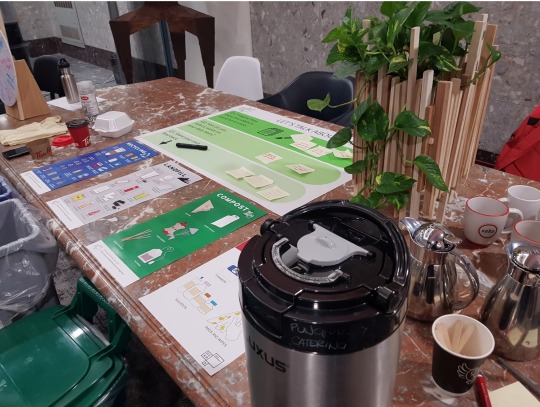
In October, ODESI hosted programming for the national Waste Reduction Week, where we held various events regarding waste at OCADU and how to avoid it. An important component of the icons project was to get feedback from students and the university community about the icons and their effectiveness. Myself along with two internship students (Priscilla Lee and Victoria Gonzales), ran activities at 230 Richmond, and 100 McCaul. We collected common waste items from our homes and brought them in and asked participants to pick two items from our pile. The first item would be one they knew how to dispose of, and one that was perhaps difficult -and confusing for them. Through this activity, participants were able to interact with the icons and use them to make their waste choices, as well as sparking conversations about waste at OCAD, complicated recycling rules, consumption, among many other intriguing conversations.
Signage iterations:

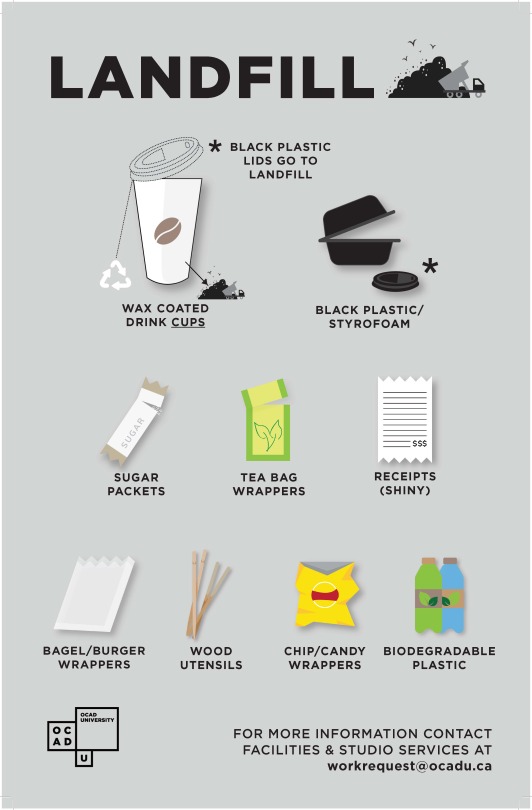

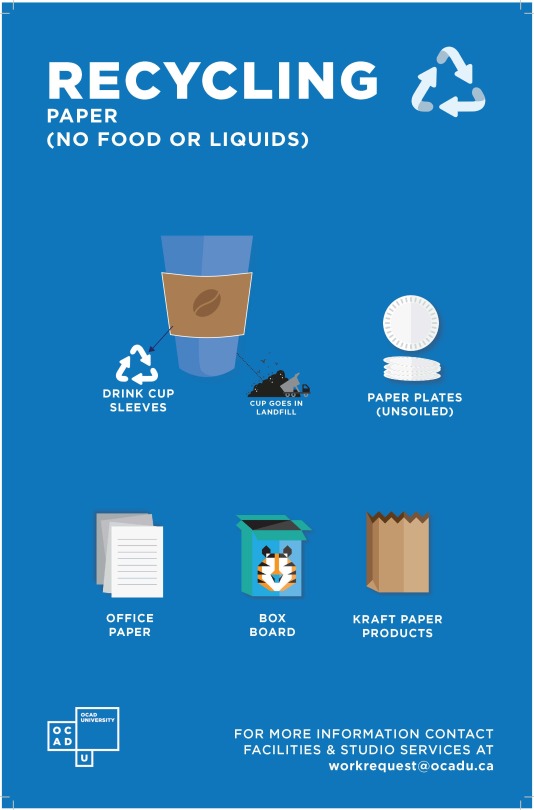
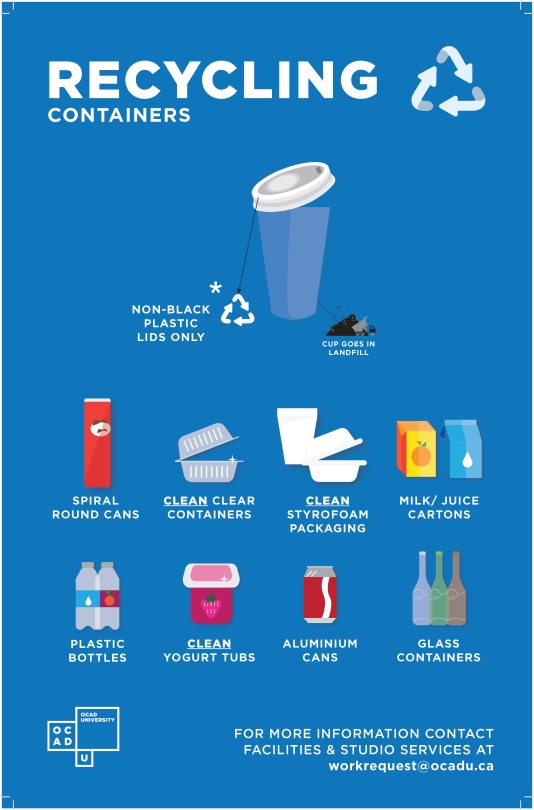
The process of creating these icons was a great opportunity to look into ways in which the waste systems interact with one another and with our capitalist culture of consumption. My role at ODESI gave me an opportunity to work closely with Victoria Ho, the Sustainability Coordinator, who became a mentor and who I worked closely with to complete this project. Her expertise and experience allowed be to broaden my range of knowledge on this topic, and encourages me to question and constantly think about the systems, institutions and industries involved in waste. This project allowed me to make a tangible contribution to this ongoing conversation, and hopefully the icons and waste solutions will evolve and improve as time passes. The posters were put up during GradEx, and seeing them out in the world for the first time was a very very cool experience! I hope that with time, the community begins to familiarize themselves with the icons, and that they serve the purpose long term that we have worked so hard for. I encourage students, faculty and any member of the OCADU community to think twice about consumption, and of where and why we are throwing things away.
Rationale for creating separate recycling streams
The most updated waste management icons follow the City of Toronto’s recycling and landfill requirements. I used the Green for Life lists as a reference, and filtered the items through waste wizard. The intention of having three different recycling signs is to separate possible liquid and food remains in containers (i.e.: Styrofoam containers and plastic water bottles) with paper recycling. If these recycling items are placed in the same bin without proper cleaning and drying, the paper recycling will become un-recyclable and that bag of recycling will become contaminated – leading it to the landfill. We want to ensure that items reach their intended waste management stream, and contamination tends to be the main reason for this not happening.
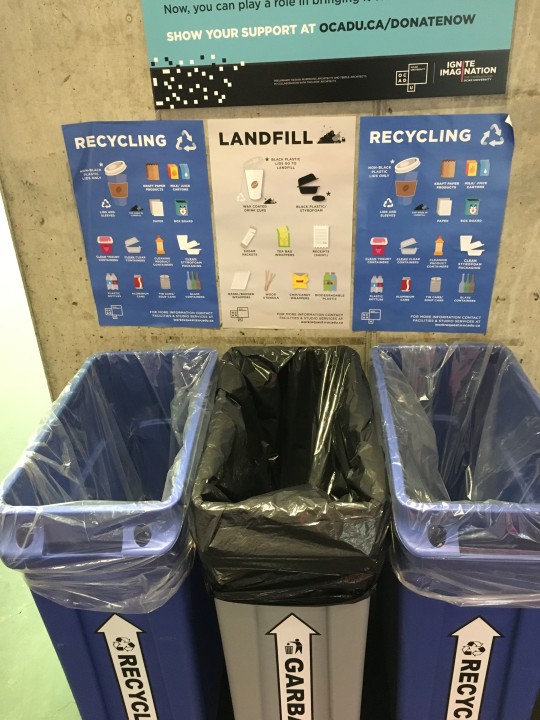
Artist Statement
These waste management icons are tools to aid in the proper categorization of the three streams of waste at OCAD University: Landfill, Recycling and Compost. Contamination is very common in these waste streams, and a design solution to combat this issue that decreases the ability for items to be recyclable, leading them to landfills. I chose to create icons of the items for a more streamlined visual language, and for the ability to control and change colours, shapes, and quantities easily. The idea for this project is that this is the starting point of a system that will change with time and new developments, laws, and methods in waste management.
0 notes
Photo

Did you know that we also stock baby food & formula in the Student Pantry? Stop by our office M-F, 9:30-4:30 if you need to access this service, no questions asked. <3
1 note
·
View note
Text
Waste Reduction Week at OCADU
Join us in partnership with the OCAD U Learning Zone to donate art supplies to our Reuse Depot! We will also be celebrating all week with an interactive textile installation in the Great Hall of 100 McCaul and other activities, such as today’s hanging planter workshop in the lobby from 1 to 3 pm!

0 notes
Text
Earth Hour 2018 - Keeping on the lights

Image by: Mauricio Eduardo Villar Martinez Text description of image: A green bullfrog leaps towards black and rainbow-coloured cycles that are reminiscent of the rings of a tree, or a fingerprint, or an oil patch, or perhaps a topographical map. A windmill image demonstrates renewable energy. OCAD U is keeping on the lights on for Earth Hour.
Historically, OCAD U celebrated Earth Hour by turning off the lights in 100 McCaul. This process cost the school $750 and required vacating the facilities. Since 2016, OCAD U has been redefining Earth Hour.
Saturday March 24, 2018, OCAD U is teaming up with Bullfrog Power. OCAD U is powering the campus for 24 hours with 100% renewable and carbon-neutral energy.
OCAD U is displacing 6.7 tonnes of CO2e by investing in 24h of renewable energy from Bullfrog Power. That’s the equivalent of 25,135km driven by an average car.
How? Bullfrog Power’s generators will inject 41,920MWh of green electricity to match our campus electricity use. Learn more: www.bullfrogpower.com
Brought to you by: The Office of Diversity, Equity & Sustainability Initiatives and Facilities & Studio Services.
Written by: Victoria Ho, Sustainability Coordinator, Office of Diversity, Equity & Sustainability Initiatives (ODESI)

Image by: Rana Zandi Text description of image: Solar panels on top of illustration of 100 McCaul St building, surrounded by green hills, trees, butterflies, and a bicycle.
0 notes
Text
Sustainability Forum 2018

Merwad Abdallah investigates grOCAD’s avocado-based dyes

Andre Baynes presents on ‘Design Education for Food Sovereignty’

grOCAD leaders Alyssa Haggerstrom and Terry Anastasiadis demonstrate natural dyes from their workshop hosted by grOCAD at Fibre Studios. Ingredients include avocado pit and onion skin!

Strategic Foresight and Innovation students lead a workshop on zero waste at OCAD U.
The Sustainability Forum created an opportunity for dialoguing across disciplines. OCAD U community members have requested opportunities to collectively dream and troubleshoot on sustainability and environmental justice at OCAD U and beyond. This includes requests for social space and dialogue, for pause and respite, for showcasing research, for collaboration, and for learning about relevant OCAD U processes and initiatives.
The Forum was physically interwoven within the Festival of the Body, co-curated by Wrik Mead and Natalie Waldburger. After sharing a lunch catered by NishDish, faculty, staff, and students participated in Theatre of the Oppressed techniques, workshopped thesis projects, and learned of sustainability-related research and programming occurring here at OCAD U.
Participants described the Forum as a way to encounter ideas and people whom might not have otherwise met, where seemingly disparate ideas were woven together to make sense of a systems-approach to sustainability and environmental justice. With about twenty Forum participants from across OCAD U and from our external community, students were especially invited to explore their ideas in a public yet intimate space that facilitated cross-pollination. Presentation topics included: Design education for food sovereignty, curatorial practices in relationship to plants, biological materials for furniture, food security & spatial usage, and waste management.
The Forum concluded with tangible ways to apply ideas and get involved. Strategic Foresight and Innovation graduate students led a design-thinking workshop on waste management at OCAD U. The workshop invited participants to troubleshoot the various intertwining systems involved for the purchase, use, and disposal/recovery of materials at OCAD U. Student Union opened discussion to determine pathways towards accessing kitchen space for students at the University. And to wrap up the Forum, the grOCAD student group showcased the fruits of their labour from their Natural Dyes Workshop, which took place concurrently in Fibre Studios. grOCAD incorporated food materials from Hot Lunch for making the dyes, beautifully demonstrating the multiple benefits of taking a lifecycle approach to materials and resources.
The Forum brought together the many stories of sustainability at OCAD U!
Special thanks to our presenters: Andre Baynes Priyasha Singh Erica Cristobal SFI Consulting Team: Merwad Abdallah, Lindsay Clarke, Lesley Foulds, Chris Leveille grOCAD: Alyssa Haggstrom, Terry Anastasiadis
Written by: Victoria Ho, Sustainability Coordinator, Office of Diversity, Equity & Sustainability Initiatives (ODESI)
0 notes
Text
OCAD U’s First Repair Cafe
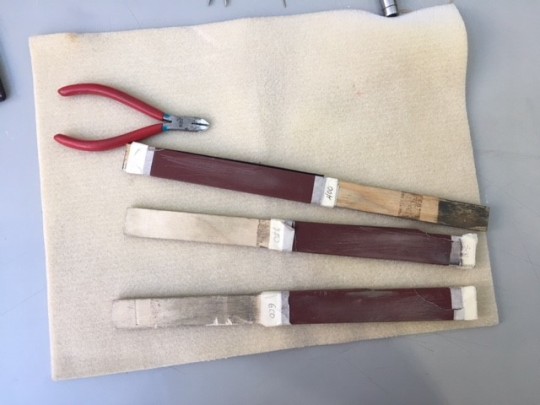
The tools resting before action!
Throw away? No way!
On Feb 14, OCAD U’s Sustainability Committee and ODESI hosted its inaugural OCAD U Repair Café. Repair Café is a global movement to reduce materials sent to landfill and transform society’s throw-away mindset. Volunteer ‘fixers’ invited members of the OCAD U community and the public to develop skills repairing jewelry and textile items. Our enthusiastic Fixers were made up of faculty, students, and community members. Over 50 items were successfully repaired! As per Repair Cafe tradition, a bell was rung after each repair. 100 McCaul lobby was filled with the music of fixing!
Great connections were shared. Faculty took on student apprentices during the event. Faculty and students led a sewathon to create and give away handkerchiefs from scrap fabrics, in an effort to reduce single use paper towels. An OCAD U alumnus from Class of 1978 joined as a Fixer, her first time visiting OCAD U since graduating! A full-circle delight. And in addition to the participating OCAD U students/staff/faculty/alumni and neighboring residents, a Grade 11 geography class studying the value of circular economies took a field trip to Repair Cafe. We discussed disposability as a design flaw and the students came prepared with materials for repair.
As a small intervention in an economy that is hungry for single use, the OCAD U Repair Café exemplified the multiple benefits generated by sustainability: reduced disposability and material consumption, financial savings, community-building, skills sharing, and neighborhood engagement.Thanks everyone! And thanks to the Repair Cafe Toronto community, who provided mentorship and even came out to visit OCAD U’s event. Written by: Victoria Ho, Sustainability Coordinator, Office of Diversity, Equity & Sustainability Initiatives (ODESI)
Photos by: Cathy Cappon

Prof. Kathleen Morris and Zev Farber revive a jacket pocket.

Prof. Rob Mitchell surrounded by beads and bobbles.
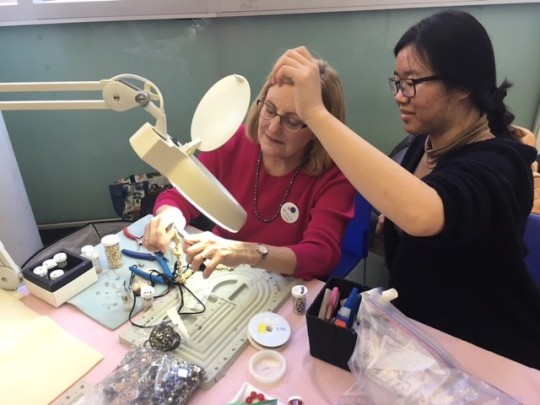
Community member Pauline Tetley with OCAD U student apprentice Salisa Jatuweerapong.

OCAD U community members picking out their handkerchief/ tenugui.

Prof. Lynne Heller teaching zipper repair to a community member.

Prof. Ken Vickerson manipulating metal to bring necklaces back to life.

OCAD U student Anita is thrilled to repair Shamina’s knitted cat sweater!

Viola, Anita, and Emma working with community members on repair.

Prof Beverly Dywan leads the sewathon and asks the OCAD U community, What is your commitment to reducing waste?
0 notes
Text
Three Hours in One Minute - Sustainability Forum 2017 video
Thanks to Rana Zandi for creating a 1-minute video summary of the OCAD U Sustainability Forum 2017. Below is the accompanying descriptive text.
youtube
Video opens to the entrance of the OCAD University Open Gallery (49 McCaul Street - where the Forum was hosted), panning down to the doors where the Sustainability Forum poster is displayed on the left door.
Yellow text in the left corner of the screen reads 'Making Meaning, Taking Action: Sustainability Forum 2017'
The view changes to inside the gallery, during the Forum. Yellow text reads 'A portrait of sustainability in action at OCAD U', as a presenter speaks at the front of the room to the audience who are seated in white chairs around them.
A close up of a poster is shown from Sustainability Forum 2015 by Ayomide Sami- Orungbe where participants responded to the prompt, "My commitment to sustainability is..." . The poster has several photographs of members of the OCAD U community holding up handwritten signs responding to the question, mostly with red backgrounds.
The view shifts to Lillian Allen performing spoken word. The yellow text reads 'Spoken Word Performance'. The view shifts to a profile view of three people participating in the group spoken word activity hosted by Lillian and her spoken word class. View shifts to a person taping up a line from Lillian's poem onto a poster. The poster already has several other lines taped to it - a creative collaboration by reorganizing the lines of the poem.
The view shifts to a person sticking icons on a graphic map of Toronto's downtown core. Yellow text appears and reads 'Embedding sustainability into an interactive map of City of Toronto'. The camera shifts to a close up to OCAD U on the map which is surrounded by icons of trees, a landscape, a solar panel, a man in a wheelchair and a bicycle.
The video shifts back to some more spoken word of a trio performing. Yellow text reads 'Collective Poetry Writing'. The video shifts to a low angle of a performer reciting spoken word while playing the guitar, a person is holding the mic up for her.
The video shifts to a focused shot of someone's hands holding a small version of the Forum's poster.
The video shifts to an over-the-shoulder shot of a participant writing on paper that is taped to the wall. They write 'SHARED RESPONSIBILITY' in blue marker and then circles it.
The video shifts, a participant waves to the camera, smiling.
The video shifts into a casual conversation between audience members.
The video shifts to someone drawing on a large piece of paper that has been taped to a window. The drawing reads '20 Min Challenge' as a header with two diagrams right below. The first is a water bottle followed by an arrow as the bottle is transformed into a planter, with a plant growing out of it.
The video shifts to The Steam Canoe models - a winter shelter project - that were showcased at the event.
The video shifts to a point of view perspective where your wrist is linked to several others with plastic bags/nets.
The screen goes black. Yellow text in the left bottom corner reads "Brought to you by the Office of Diversity, Equity, and Sustainability Initiatives and the OCAD U Sustainability Committee"
The screen goes black.
Yellow text appears again in the top left corner reading "Thanks to our presenters: Greg Dammery, Lillian Allen, Tyler Sewell, Ehiko Odeh, Ivan Maycheck, D'Andrea Bowie- Defilippis, Jonathan Atkins, Stephanie Caldeira, Sammi Goldman, Mitch Joiner, Alexie Laverdiere Ranger, Christopher Lloyd, Roda
By Simran Dadlani, Student Monitor, Office of Diversity, Equity & Sustainability Initiatives (ODESI)
0 notes